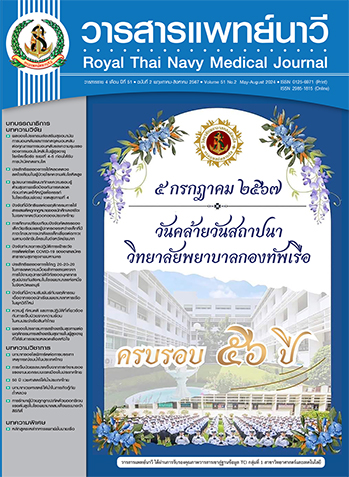Hyperbaric Oxygen Therapy for Treatment of Malayan Pit Viper Bite Patients at Somdej Pranangchaosirikit Hospital
Main Article Content
Abstract
Malayan pit viper is a snake that can be found in every region of Thailand. Its venom affects the blood coagulation system and local complication at the bite site. Although the chance of death is found to be low, most of the patients often show local complication. The main complication are compartment syndrome and tissue necrosis. In cases that the patient has severe symptoms, surgical treatment is required and many patients become disabled. Somdej Pranangchaosirikit hospital has used hyperbaric oxygen therapy to prevent and treat local complication in patients bitten by Malayan pit viper to reduce disability from local complication. From the data collection in 33 patients from May 2013 - May 2018, it was found that HBO2T could reduce compartment syndrome and extensive tissue necrosis, as well as reduce the incidence of fasciotomy and debridement, thereby contributing to a reduction in the incidence of Malayan pit viper bite morbidity. There should be clear indications for selecting patients for HBO2T. However, further randomized control trial study is still needed.
Article Details

This work is licensed under a Creative Commons Attribution-NonCommercial-NoDerivatives 4.0 International License.
References
Laohawiriyakamol S, Sangkhathat S, Chiengkriwate P, Patrapinyokul S. Surgery in management of snake envenomation in Children. World J Pediatr 2011;7(4):361-4.
Russell FE. Snake venom poisoning in the United States. Annu Rev Med 1980;31:247-59.
Ahmed SM, Ahmed M, Nadeem A, Mahajan J, Choudhary A, Pal J. Emergency treatment of a snake bite: Pearls from literature. J Emerg Trauma Shock 2008;1(2):97-105.
Mion G, Olive F, Giraud D, Lambert E, Descraques C, Garrabé E, et al. Clinical and biological surveillance of envenomed patients. Bull Soc Pathol Exot 2002;95(3):139-43.
Wongtongkam N, Wilde H, Sitthi-Amorn C, Ratanabanangkoon K. A study of 225 Malayan pit viper bites in Thailand. Mil Med 2005;170(4):342-8.
Ho M, Warrell DA, Looareesuwan S, Phillips RE, Chanthavanich P, Karbwang J, et al. Clinical significant of venom antigen levels in patients envenomed by the Malayan pit viper (Calloselasma rhodostoma). Am J Trop Med Hyg 1986;35(3):579-87
Chattopadhyay A, Patra RD, Shenoy V, Kumar V, Nagendhar Y. Surgical implications of snakebites. Indian J Pediatr 2004;71(5):397-9.
Warrell DA, Looareesuwan S, Theakston RD, Phillips RE, Chanthavanich P, Viravan C, et al. Randomized comparative trial of three monospecific antivenoms for bites by the Malayan pit viper (Calloselasma rhodostoma) in southern Thailand: clinical laboratory correlations. Am J Trop Med Hyg 1986;35(6):1215-17.
Roberts RS, Csencsitz TA, Heard CW Jr. Upper extremity compartment syndromes following pit viper envenomation. Clin Orthop Relat Res 1985;193:184-8.
Glass TG Jr. Early debridement in pit viper bites. JAMA 1976;235:2513-6.
Glass TG Jr. Early debridement in pit viper bite. Surg Gynecol Obstet 1973;136(5):774-6.
Garfin SR, Castilonia RR, Mubarak SJ, Hargens AR, Akeson WH, Russell FE. The effect of antivenin on intramuscular pressure elevations induced by rattlesnake venom. Toxicon 1985;23(4):677-80.
Stewart RM, Page CP, Schwesinger WH, McCarter R, Martinez J, Aust JB. Antivenin and asciotomy/debridement in the treatment of the severe rattlesnake bite. Am J Surg 1989;158(6):543-7.
Myers RA. Hyperbaric oxygen therapy for trauma: crush injury, compartment syndrome, and other acute traumatic peripheral ischemias. Int Anesthesiol Clin 2000;38(1):139-51.
Fitzpatrick DT, Murphy PT, Bryce M. Adjunctive treatment of compartment syndrome with hyperbaric oxygen. Mil Med 1998;163(8):577-9.
Wattel F, Mathieu D, Neviere R, Bocquillon N. Acute peripheral ischaemia and compartment syndromes: a role for hyperbaric oxygenation. Anaesthesia 1998;53(Suppl 2):63-5.
Garcia-Covarrubias L, McSwain NE, Jr, Van Meter K, Bell RM. Adjuvant hyperbaric oxygen therapy in the management of crush injury and traumatic ischemia: an evidence-based approach. Am Surg 2005;71(2):144-51.
Nylander G, Lewis D, Nordstrom H, Larsson J. Reduction of postischemic edema with hyperbaric oxygen. Plast Reconstr Surg 1985;76(4):596-603.
Tibbles PM, Edelsberg JS. Hyperbaric-oxygen therapy. N Engl J Med 1996;334(25):1642-8.
Skyhar MJ, Hargens AR, Strauss MB, Gershuni DH, Hart GB, Akeson WH. Hyperbaric oxygen reduces edema and necrosis of skeletal muscle in compartment syndromes associated with hemorrhagic hypotension. J Bone Joint Surg Am 1986;68(8):1218-24.
Gold BS, Barish RA, Dart RC, Silverman RP, Bochicchio GV. Resolution of compartment syndrome after rattlesnake envenomation utilizing non-invasive measures. J Emerg Med 2003;24(3):285-8.
Rainer PP, Kaufmann P, Smolle-Juettner FM, Krejs GJ. Hyperbaric oxygen in the treatment of puff adder (Bitis arietans) bite. Undersea Hyperb Med 2010;37(6):395-8.
Stolpe MR, Norris RL, Chisholm CD, Hartshorne MF, Okerberg C, Ehler WJ, et al. Preliminary observations on the effects of hyperbaric oxygen therapy on western diamondback rattlesnake (Crotalus atrox) venom poisoning in the rabbit model. Ann Emerg Med 1989;18(8):871-4.
Kelly JJ, Khosro S, Gottlieb SF, Ownby CL, Van Meter KW, Torbati D. Reduction of rattlesnakevenom- induced myonecrosis in mice by hyperbaric oxygen therapy. J Emerg Med 1991;9(1-2):1-7.
Silpsrikul P. Treatment of Malayan pit viper bite patients by hyperbaric oxygen therapy. RTN Med J 2014;41(3):75-88. (in Thai).

